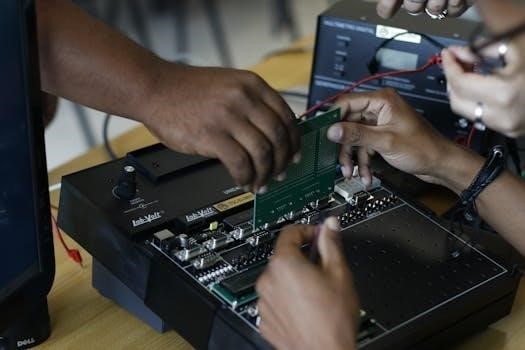
Looking for a DSC PC1832 programming manual in PDF format? You’re in luck! Many resources offer downloadable manuals for this security system. These guides provide essential installation‚ wiring‚ and programming instructions. Accessing the PDF ensures you have the necessary information for optimal system setup and operation.
The DSC PC1832 is a robust alarm system designed to provide comprehensive security for homes and businesses. Known for its flexibility and reliability‚ the PC1832 supports up to 32 zones‚ accommodating a wide range of security devices such as door and window sensors‚ motion detectors‚ and smoke detectors. This scalability makes it suitable for both small apartments and large properties.
One of the key features of the DSC PC1832 is its programmable nature‚ allowing users to customize the system to meet their specific security needs. Proper programming is essential for ensuring that the system functions correctly and provides adequate protection; This includes defining zones‚ setting user access codes‚ and configuring system options.
To effectively program the DSC PC1832‚ access to the programming manual is crucial. The manual contains detailed instructions and step-by-step guides on how to navigate the system’s programming interface. It also provides information on troubleshooting common issues that may arise during the programming process. With the manual‚ users can confidently configure their alarm system for optimal performance.
Finding the DSC PC1832 Programming Manual
Locating the DSC PC1832 programming manual is essential for anyone looking to configure or troubleshoot their alarm system. The manual provides detailed instructions on accessing programming mode‚ defining zones‚ setting user codes‚ and enrolling wireless devices. Fortunately‚ there are several avenues to explore when searching for this valuable resource.
Firstly‚ check the DSC website. DSC often provides downloadable manuals for their products‚ including the PC1832. Look for the support or downloads section and search for your specific model. You may find the programming manual‚ reference manual‚ and installation guide available as PDF files.

Secondly‚ online forums and communities dedicated to security systems can be a great resource. Users often share manuals and offer advice on where to find them. Websites specializing in security equipment manuals may also host the DSC PC1832 programming manual.
Finally‚ consider contacting your alarm system installer or provider. They may be able to provide you with a copy of the manual or direct you to a reliable source. Remember to specify the exact model number to ensure you receive the correct documentation.
Key Components for Programming
Successfully programming a DSC PC1832 alarm system hinges on understanding its key components. First‚ the control panel itself is the central hub‚ storing programming data and managing system functions. The keypad serves as your primary interface for inputting commands and viewing system status. Different keypads‚ such as the PK5500‚ offer enhanced features compared to the PK5501‚ streamlining the programming process.
Zone expanders‚ like the PC5108‚ are crucial for systems with numerous zones‚ enabling the connection of additional sensors. The programming manual is indispensable‚ providing step-by-step instructions for various configurations. A reliable power supply ensures uninterrupted operation during programming.
Understanding zone descriptors is vital for clearly identifying each sensor’s location (e;g.‚ “Front Door‚” “Living Room Window”). Access codes‚ including the master access code and user codes‚ control system access and operation. Finally‚ for wireless systems‚ the wireless receivers and enrolled devices are essential components that need configuration. These elements work together to customize and optimize your DSC PC1832 system.
Accessing Programming Mode
Gaining entry into programming mode on your DSC PC1832 system is the initial step for any configuration changes. Typically‚ this process involves using the keypad and the installer code. Begin by entering *8 followed by the current installer code. The default installer code is often 5555‚ but this may have been changed.
Upon successful entry‚ the keypad will indicate that you are in programming mode‚ usually by displaying a specific message or flashing an indicator light. If the initial attempt fails‚ ensure you are using the correct installer code. If the code has been forgotten‚ consult the programming manual or contact a qualified technician for assistance.
Once in programming mode‚ you can navigate through various sections to configure zones‚ user codes‚ and other system settings. Remember to consult the programming manual for detailed instructions and available options. Exiting programming mode usually involves pressing the # key. Always verify that the changes have been saved before exiting to avoid losing any configurations. Proper access to programming mode is essential for customizing your DSC PC1832 system to your specific needs.
Zone Definition and Programming
Zone definition and programming are crucial steps in setting up your DSC PC1832 alarm system. Each zone corresponds to a specific area or sensor within your property‚ such as doors‚ windows‚ or motion detectors. Programming these zones correctly ensures accurate monitoring and response from the system.
To begin‚ you need to access the programming mode of your system‚ typically by entering *8 followed by the installer code. Once in programming mode‚ navigate to the zone definition section. Here‚ you can assign attributes to each zone‚ such as zone type (e.g.‚ entry/exit‚ interior‚ perimeter) and response time. The zone type determines how the system reacts when the zone is triggered‚ while the response time sets the delay before an alarm is activated.
It’s essential to carefully plan your zone assignments to match the layout and security needs of your property. Properly defined zones allow the system to differentiate between various types of events and respond accordingly. Remember to consult the DSC PC1832 programming manual for detailed instructions and available options. Test each zone after programming to ensure it functions correctly‚ providing reliable security coverage.
Programming Zone Descriptors
Programming zone descriptors in your DSC PC1832 system enhances user experience and makes identifying alarm events easier. Zone descriptors are simply names or labels assigned to each zone‚ such as “Front Door‚” “Living Room Window‚” or “Basement Motion.” These descriptors appear on the keypad display when a zone is triggered‚ providing clear information about the location of the event.
To program zone descriptors‚ you typically enter a specific programming section using the installer code. The keypad will then guide you through the process of entering the desired name for each zone. Since keypads often have limited character displays‚ you may need to use a combination of numbers and symbols to represent letters.
Clear and descriptive zone descriptors are invaluable when an alarm occurs‚ allowing you and emergency responders to quickly understand the situation. A well-labeled system also simplifies troubleshooting and maintenance. Refer to the DSC PC1832 programming manual for exact steps and character mapping. Invest time in programming descriptive descriptors for a user-friendly and effective security system.
User Access Code Programming
User access code programming is a critical aspect of configuring your DSC PC1832 security system. In addition to the master access code‚ which is typically reserved for the system administrator or homeowner‚ you can program multiple user codes to grant access to other individuals‚ such as family members‚ trusted neighbors‚ or cleaning services.
Each user access code allows individuals to arm and disarm the system without needing the master code. This enhances security by limiting knowledge of the master code to a select few. To program user codes‚ you’ll typically enter a specific programming section using the master code. You can then assign a unique code to each user‚ often with options to set restrictions or permissions.
For example‚ you might restrict a user code to only disarming the system during certain hours. Regularly review and update user access codes‚ especially when someone no longer requires access. Proper user access code management ensures your system remains secure and that only authorized individuals can control it. Always consult your DSC PC1832 programming manual for detailed instructions and best practices.
Wireless Device Enrollment
Wireless device enrollment is a key feature of the DSC PC1832‚ allowing for easy integration of sensors and peripherals without extensive wiring. The process typically involves entering a specific programming section on your keypad and then following the prompts to enroll each wireless device individually. The system needs to learn the unique identification code of each device to communicate effectively.
One common method is auto-enrollment‚ accessed through a dedicated section in the programming menu‚ which simplifies the process if available. This method automatically detects and enrolls compatible devices. Alternatively‚ manual enrollment requires entering the device’s serial number or other identification information. Ensure that the wireless devices are within range of the control panel during the enrollment process.
Testing the communication between each enrolled device and the panel is crucial to confirm proper functionality. The DSC PC1832 manual provides detailed steps and troubleshooting tips for successful wireless device enrollment. Proper enrollment ensures that all sensors‚ such as door/window contacts and motion detectors‚ are correctly linked‚ maintaining the integrity and reliability of your security system. Always refer to the DSC PC1832 programming manual for specific guidance.
Wiring and Installation Guide
The wiring and installation of the DSC PC1832 are critical for ensuring optimal system performance and reliability. This process involves connecting various components‚ including the control panel‚ keypads‚ sensors‚ and power supply‚ according to specific wiring diagrams and guidelines provided in the installation manual. Proper grounding and secure wire connections are essential to prevent electrical interference and ensure consistent operation.
The installation guide outlines the correct methods for wiring zones‚ auxiliary power outputs‚ and communication modules. It emphasizes the importance of using appropriate wire gauges and following color-coding conventions to avoid errors. Before starting the installation‚ it’s crucial to disconnect the power supply to prevent electrical shock. Careful attention to detail during wiring ensures that each component functions as intended‚ providing comprehensive security coverage.
The guide also provides instructions for mounting the control panel and keypads in secure and accessible locations. It includes diagrams illustrating the proper placement of sensors to maximize their effectiveness. The DSC PC1832 installation manual is an indispensable resource for anyone installing or maintaining the system‚ offering step-by-step instructions and troubleshooting tips to ensure a successful and reliable setup. Refer to the manual for detailed specifications and best practices.
Troubleshooting Common Programming Issues
Programming the DSC PC1832 can sometimes present challenges. Common issues include incorrect zone definitions‚ user access code errors‚ and wireless device enrollment failures. When troubleshooting‚ the first step is to verify all connections and ensure the system is powered correctly. Consult the programming manual PDF for specific error codes and their corresponding solutions.
Incorrect zone definitions often lead to false alarms or unresponsive sensors. Double-check the zone wiring and programming settings‚ ensuring they match the physical layout of your security system. User access code errors can occur if the master code is forgotten or if new codes are entered incorrectly. Refer to the manual for instructions on resetting the master code and programming new user codes.
Wireless device enrollment issues may arise due to signal interference or incorrect device settings. Ensure that wireless devices are within range of the control panel and that their batteries are adequately charged. The programming manual provides detailed steps for enrolling wireless devices and troubleshooting connectivity problems. By systematically addressing these common programming issues‚ you can ensure the DSC PC1832 operates effectively and provides reliable security.
Keypad Usage for Programming
The keypad serves as the primary interface for programming the DSC PC1832 alarm system. Understanding its functions and navigation is essential for successful system configuration. Keypads like the PK5500 are preferred for their user-friendly displays‚ which simplify the programming process compared to models like the PK5501.
To enter programming mode‚ you typically need to enter the installer code followed by a specific command. The programming manual PDF provides a detailed list of commands and their corresponding functions. Navigating through the programming options involves using the arrow keys to select different sections and the number keys to enter data.
The keypad display provides feedback on the current settings and any errors that may occur during programming. It’s crucial to pay attention to these messages and consult the manual for troubleshooting guidance. Keypad beeps also indicate various system states‚ such as confirmation of a successful entry or an error warning. Familiarizing yourself with these auditory cues can streamline the programming process and help you quickly identify and resolve any issues.
Reference Manual and Additional Resources
Beyond the programming manual‚ the DSC PC1832 reference manual is a vital resource‚ offering in-depth explanations of system features and functionalities; This document‚ often available for download from the DSC website‚ provides detailed information on advanced programming options and troubleshooting procedures.
Additional resources include quick installation guides that summarize the essential steps for setting up the system. Online forums and communities dedicated to security systems can also provide valuable insights and assistance from experienced users and installers. These platforms often feature discussions on specific programming challenges and solutions.
Furthermore‚ consider exploring resources like sensor group zone descriptions and compatibility guides for devices like the GT Plus Cellular Communicator. These documents ensure seamless integration and optimal performance of your DSC PC1832 system. Always refer to the latest versions of these manuals and guides to stay updated with the most current information and best practices for programming and maintaining your security system.

Importance of Installer Instructions
Installer instructions are paramount for the proper setup and configuration of the DSC PC1832 alarm system. These instructions provide specific guidance tailored to professional installers‚ ensuring the system is wired‚ programmed‚ and tested according to industry standards and safety regulations.

The installer manual covers essential aspects such as wiring diagrams‚ zone configurations‚ and advanced programming features that may not be included in the user manual. It also details how to meet UL Listing requirements‚ ensuring the system adheres to safety and performance benchmarks.
Furthermore‚ installer instructions offer troubleshooting tips and solutions to common installation issues‚ helping to avoid errors and ensure the system operates reliably. These manuals often include detailed explanations of keypad functions and programming sequences‚ enabling installers to customize the system to meet the specific needs of the user.
Accessing and following the installer instructions is crucial for maximizing the effectiveness and longevity of the DSC PC1832 alarm system. Ignoring these guidelines can lead to improper installation‚ system malfunctions‚ and potential security vulnerabilities.
